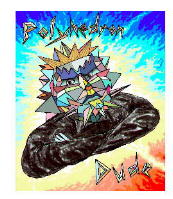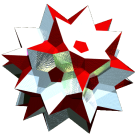compound of 10 tet
©
⭳ ©
(at margins)
- between {3} and {3}: arccos(1/3) = 70.528779°
links



| Acronym | e |
| Name |
icosiicosahedron, compound of 10 tet |
| Coxeter symbol | 2{5,3}[10{3,3}]2{3,5} |
| |
| VRML |
|
| Circumradius | sqrt(3/8) = 0.612372 |
| Inradius | 1/sqrt(24) = 0.204124 |
| Vertex figure | 2[33] |
| General of army | doe |
| Colonel of regiment | (itself, although not being locally convex) |
| Admiral of fleet | ike |
| Dual | selfdual |
|
Dihedral angles
(at margins) |
|
| Confer | |
|
External links |



|
Both the triangles pairwise fall into coincident face planes, and the vertices coincide by pairs. So either both can be considered separately (type A); or vertices are identified, while triangles are kept separately (type B); or conversely, vertices are considered separately, while faces are considered as (rotated) 2-triangle-compounds (type C); or finally both are considered combined (type D). Clearly types A and D are selfdual, while types B and C are anothers duals.
Finally e also is a compound of 2 (different handed) ki (type E).
The edge-on picture obove shows that this compound does not have a mirror symmetry wrt. its mid-edge plane. Thence it is not flag transitive and thus not regular in this sense. Even though, it both has a regular solid for its hull (doe) and for its kernel (ike). Thence it is regular in the sense of Coxeter.
(Type A) 40 | 3 | 3 || 1 ----+----+----++--- 2 | 60 | 2 || 1 ----+----+----++--- 3 | 3 | 40 || 1 ----+----+----++--- ♦ 4 | 6 | 4 || 10
(Type B) 20 | 6 | 6 || 2 ----+----+----++--- 2 | 60 | 2 || 1 ----+----+----++--- 3 | 3 | 40 || 1 ----+----+----++--- ♦ 4 | 6 | 4 || 10
(Type C) 40 | 3 | 3 || 1 ----+----+----++--- 2 | 60 | 2 || 1 ----+----+----++--- 6 | 6 | 20 || 2 ----+----+----++--- ♦ 4 | 6 | 4 || 10
(Type D) 20 | 6 | 6 || 2 ----+----+----++--- 2 | 60 | 2 || 1 ----+----+----++--- 6 | 6 | 20 || 2 ----+----+----++--- ♦ 4 | 6 | 4 || 10
(Type E) 40 | 3 | 3 || 1 -----+----+----++-- 2 | 60 | 2 || 1 -----+----+----++-- 3 | 3 | 40 || 1 -----+----+----++-- ♦ 20 | 30 | 20 || 2
© 2004-2025 | top of page |